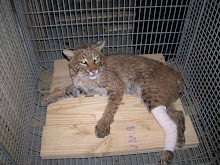The baby starlings are climbing out of their nest now, so have been put into a reptarium (mesh cloth cage) for safe-keeping and to give them room to exercise those little legs. I'm still waiting for everyone to start eating on their own. The finches have started nibbling at the seed, but really aren't "eating-eating" yet, other than a few bits here and there. It's a start, though, and I've hung a millet spray in with them. I'll be able to tell fairly easily if they begin cracking those seeds, as the bottom of the cage below it will be littered with empty shells. Let's hope that happens soon.
I've got to get outdoor facilities set up so that, as soon as these babies are eating self-sufficiently and able to fly, I can move them safely outside. Once outdoors, they'll begin to adapt to the point that they can eventually be released. I've got great plans ... now for the resources to bring them to reality!
A call came in today. A kind gentleman found a baby fawn near the road.
I think this is a good opening to simply remind everyone that baby animals are always better off with their mothers. Though it's natural for humans to want to shelter and protect what they perceive as orphans or abandoned babies, most of the time those babies are not abandoned at all. Mother deer do not stay with their fawns, at least not the tiny ones. They leave the babies in hiding, and only return every so many hours to nurse them. In the interim, they stay well away from the hiding site, so as not to lead predators to their offspring. If a baby deer is found, unless the dead body of the mother is nearby and evident, there is an almost 100% chance that the mother will be back looking for it soon. Mother deer don't always choose the smartest hiding places (I recall a series of photos that circulated around the internet not long ago of a fawn that was actually hidden on a family's back porch step, but the mother did come back for it). Baby deer don't always stay put (I had one, years ago, actually run into my arms, because she'd left her assigned spot and got confused -- I eventually got her to stay in the edge of the woods and, sure enough, along came mamma a couple hours later and tended to her). However, returning a baby fawn to the general vicinity of where it was found is always the best option, unless you're absolutely certain the mother is dead.
Bunnies are another species often abducted from their nests by humans who think they've been abandoned. A mother rabbit will only return to the nest once or twice a day to nurse her offspring. The rest of the time, she stays well away, because a predator won't smell or spot the hidden babies, but they might follow the adult to the nest. So often, we receive baby rabbits that good-hearted people think were abandoned because they watched for an hour and never saw the mother nearby. Mother most certainly returned at dusk to nurse her babies--only to find them gone.
Those babies, too, should have been returned to the spot where they were found.
Baby birds too small to hop around and flutter should be returned to the nest if possible, and if not, put near the nest location. A makeshift nest is easily made out of a basket, such as the plastic ones strawberries come in, lined with straw or hay or even shredded and wadded up paper towels. Even putting it in a sheltered spot on the ground near the tree that contains the original nest will allow the parents to find it. If a nest or bird falls or blows out of an opening in a house or barn, return that makeshift nest into the opening as close to the original location as possible. It's an old wive's tale that parents will reject babies that have "human smell" on them. Those mother and father birds are usually frantic over their missing offspring, and will continue to feed and tend to them on the ground, in the new nearby location, and in the human-made pseudo-nest.
Note, too, that if a baby bird is on the ground and it is old enough to hop and flutter, has feathers, and is in the "cute as a button" stage ... it's probably on the ground on purpose. Babies fall out of the nest as a normal part of their development. The parents will feed the baby on the ground until it finds its wings and learns to fly well.
Unless a baby animal is obviously injured, or you are one hundred percent certain that the parents are dead, they are always best off with their natural parents.
If there is injury or no other option, then hit Google, do a search for wildlife rehabilitators in your state or location, and try to track down someone licensed to legally and skillfully care for injured and orphaned wildlife.
I know you love animals ... you wouldn't be visiting my blog if you didn't. Part of that love is to learn the best way to be their friend. Thank you for caring so much for our wild relatives!
Some books you may enjoy:
- Healers of the Wild by Shannon Jacobs
- Introduction to Wildlife Rehabilitation by Nancy Schwartz
- Beginning Wildlife Rehab by Donna Ralph







No comments:
Post a Comment